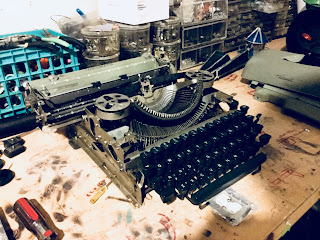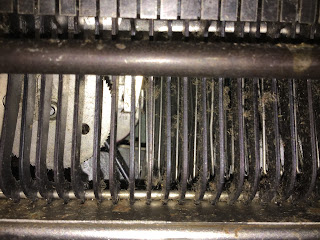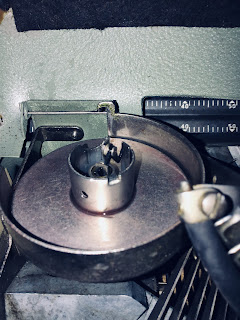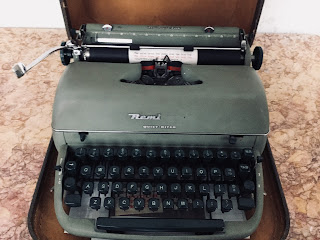1957 Remington Quiet-Riter
I was given a job of repairing this 1957 Remington Quiet-Riter that one of my friends had picked up from a resale shop. The second half of the front badge had snapped off, leaving the machine with a curious title, granting it the nickname “Remi” on behalf of the owner. It gave it character. The machine had defiantly seen better days, the surface rust was all encompassing, the paint was worn thin, the segment shift was not shifting, and the entire machine was filed with dust, spider webs, and hair.
Other than that, the entire thing was functional, it was just the amount of dirt and grime that made it appear broken. It had an American QWERTY keyboard, and typed in an Elite typeface. The original ribbon was intact and still nice and dark. As for the case, I’m not a dry cleaner. I’m a typewriter-fixer. I tried cleaning it as best I could, but it wasn’t perfect. The handle squeaked and the latch didn’t latch, but it did have a luggage tag with the original owner’s name and address. I yelled at the handle to "shut up" and it stopped squeaking immediately...I also oiled it, but I doubt that had anything to do with it. I'm a formidable person, things just like listening to me. The latch, for whatever reason decided to start latching again. Perhaps it was afraid of what I would do to it if it didn't.
The first thing I did (on the actual machine) was remove all of the body panels, for the carriage panels, the platen had to be removed. That was pretty simple, the right knob released with a set screw, and the left knob unscrewed from the left side of the platen. The entire feed-roller assembly was filled with white out, so I sanded and polished out all that I could. Everything them got carefully brushed out and soaked in mineral spirits. Forgot to mention, I soaked it in mineral spirits. Completely drenched, saturated... Soaked, one might go so far as to say... I don’t do harsh chemical cleaning or dunking, though this would have been a good machine to do it on. Everything I could get at got brushed, cleaned, and polished. I wasn’t about to tear down more than I needed to. Don’t fix what isn’t broken.
From then on, it was basically a matter of re-assembly and adjusting. The alignment had to be adjusted, the keys had to be adjusted, and the writing line had to be adjusted. I also needed to sand down all the rollers to remove the flat spots and white out. The rubber was fairly soft, so it did not need to be replaced. After that, it was several pages of testing and a new red and black ribbon. Remington’s are known for their odd spools. Some only have a top, some only have a bottom, and some have neither. The Quiet-Riter spools had no top or bottom, it was just a ring of metal that the ribbon wrapped around. Turns out it wasn’t too hard to change. I attached the new ribbon onto the old spool, and placed the new ribbon (spooled) and the old spool (to be spooled) on a flat surface and slid the old one around the new one over and over until it was transferred. Not the best way to do it, but it worked pretty darn good.
At the end, there remained a small amount of interior surface rust, but everything was working smoothly...perfectly if I might say.
Spider webs
Dirty cup
Clean cup
 |
Old ribbon
Pain-in-the-butt-spools
Ready to go back






























Pain-in-the-butt-spools! XD
ReplyDeleteI love your blog so much.
I just realized how cool this commenting style is!
Ahh, I love it!
Aww, thank you so much!!
Delete